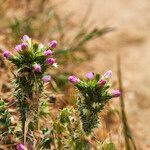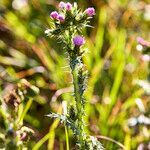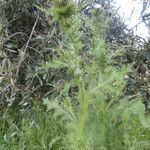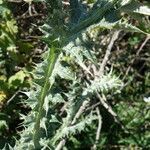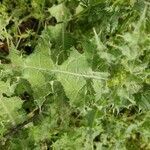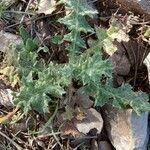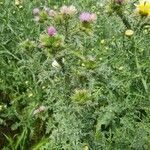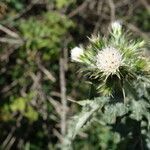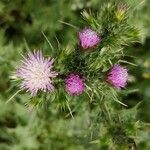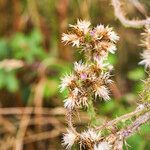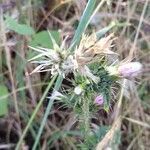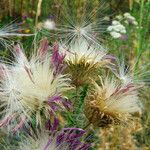Annuals, 20–200 cm. Stems simple or openly branched, loosely tomentose with fine single-celled hairs and villous with curled, septate hairs; teeth of wings to 25 mm, wing spines to 15 mm. Leaves: basal tapered to winged petioles, blades 10–25 cm, margins pinnately 6–10-lobed, abaxial faces tomentose, adaxial faces loosely tomentose and villous or ± glabrate; cauline sessile, shorter, less divided. Heads clustered in ± tight arrays of 5–20+ at ends of stems, usually sessile, 15–22 mm × 7–12 mm. Involucres cylindric to ellipsoid (appearing campanulate when pressed), 15–20 × 7–12 mm. Phyllaries linear-lanceolate, bases appressed, 2–2.5 mm wide, ± glabrate, and ascending, appendages 0.5–1.5 mm wide, narrowly scarious-margined, distally glabrous or minutely ciliolate, spine tips 1–2 mm, inner phyllaries with erect, straight, unarmed tips. Corollas pinkish, 10–14 mm; lobes 1.5–2.5 times longer than throat. Cypselae brown, 4–5 mm, finely 10–13-nerved; pappus bristles 10–15 mm. 2n = 54.
Annual or biennial herb to 1.2 m high. Stems arachnoid-hairy; wings 2–10 mm wide. Leaves grey, moderately arachnoid-tomentose above, densely arachnoid-tomentose below; glands absent; marginal spines 2–5 mm long, white to pale brown. Capitula in sessile terminal clusters of 3–10; involucre cylindrical, 15–20 mm long, 7–11 mm wide excluding patent bracts, deciduous at fruiting stage; median involucral bracts erect to patent, narrowly deltate, 13–18 mm long, 2–3 mm wide at base, with entire scarious margins, glabrous or sparsely arachnoid-hairy. Corolla tube 7–11 mm long; lobes 4.5–5 mm long. Anthers 5–6 mm long. Achenes ellipsoid, 4–4.5 mm long, pale brown with darker longitudinal streaks. Pappus bristles 147–195, 11–13 mm long.
Annual herb, up to ± 1.5 m high; stems simple or branched, furrowed, white-cottony, narrowly spinose-winged. Leaves rosetted at first, cauline at flowering time, decurrent, sinuate-pinnatifid to lyrate-pinnatipartite, lobes broad, deeply and irregularly toothed teeth spinose; glabrous or somewhat cottony above, ± cottony below. Capitula oblong or cylindric, 3-10 or more in dense, terminal clusters; involucral bracts erect, spinose, nearly glabrous to densely cottony. Florets purple, rarely white. Flowering time Oct.-Jan. Pappus soon caducous. Cypselae finely transversely wrinkled.
Annual or biennial herb, up to 1.5 m high. Stems white-cottony, narrowly spinose-winged, wings running up to base of heads. Leaves sinuate-pinnatifid to Iyrate-pinnatipartite; lobes broad, deeply and irregularly toothed, teeth spinose; cottony below. Flowers purple, rarely white; January and April to May.
A herb. It is a thistle. It grows for one or two years. It grows 50-120 cm tall.
